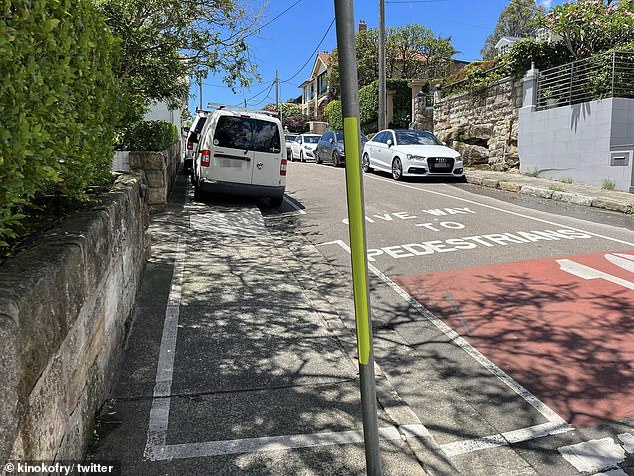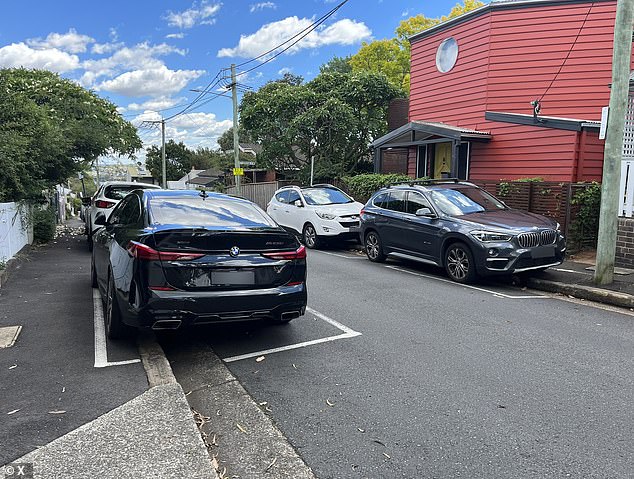Inner west Sydney residents’ outrage as cars take over entire footpaths for ‘dangerous’ new parking bays
Entire sidewalks on tight suburban streets have parking spaces painted over them, leaving no room for locals to walk.
Sydney's Inner West Council has painted parking spaces on sidewalks blocking more than 80 percent of the sidewalk in Balmain's notoriously tight back streets.
Complaints have been received from aggrieved residents who now have to walk onto the road to pass parked cars that do not leave enough room to squeeze past.
A council spokesperson said the new sidewalk spaces were needed to make way for emergency vehicles traveling through the area.
Edward Morris, CEO of the Physical Disability Council of NSW, branded the measure an unacceptable solution that has created accessibility issues for people with disabilities.

Sydney Inner West City Council has painted parking spaces on footpaths in Balmain to create more road space for emergency vehicles.

Edward Morris, CEO of the Physical Disability Council of NSW, criticized the solution as it forces pedestrians onto the road to walk around parked cars, putting them at risk
Mr Morris could not accept that the council had seemingly prioritized parking over accessibility and safety.
“Councils have a responsibility to ensure there are no access barriers and should bear in mind that the minimum width required for two wheelchair users to pass each other on a sidewalk is 1800mm,” Mr Morris said.
Locals using social media mostly agreed with him and also complained about the obvious problem of patching for the limited space on the road.
“Two parking spaces take up the entire sidewalk, putting pedestrians in the middle of the street where my partner was almost hit by a large SUV that didn't yield at all,” someone wrote on X.
“So no thoughts about people with strollers,” asked another.
“Why do we even have a footpath at this point,” a third added.
“Oh, the irony of completely blocking the sidewalk and painting 'give way to pedestrians' on the road,” said another.
A spokesperson for the municipality told 9News that it had been slowly implementing sidewalk parking for more than two decades.
“These were implemented because some streets are very restricted and there were issues such as insufficient footpath width, informal parking on footpaths, pedestrians walking on the road and insufficient road width for access for emergency services,” they said.
'This resulted in the Council attempting to treat streets with marked parking bays and 10km/h restrictions to make it safe to use the carriageway for all roads.'
Ny Breaking Australia has contacted the Inner West Council for comment.

Locals similarly criticized the move that does not accommodate strollers or wheelchairs, with one person reporting their partner was almost hit by an SUV as they had to walk onto the road
Lena Huda of WalkSydney emphasized that streets with significant amounts of traffic needed segregated sidewalks to ensure pedestrian safety.
Ms Huda said creating more space for pedestrians instead of cars “means greater freedom and accessibility for people of all abilities to move around.”
“Not just those who can drive a car and need to find a parking spot,” she said.
Motorists have long complained about the inability of Sydney's roads to accommodate the ever-increasing number of cars driving through the city.
A new exchange in Rozelle has been called 'confusing' and labeled Australia's most complicated underground exchange after it opened at the end of November.
Rebecca Clements, an urban planner studying at the University of Sydney, said the new Interchange proved that councils have always struggled to accommodate cars.
Roads Minister John Graham also said on Monday that drivers' frustrations were “real” and that certain elements of the new design should never have been approved.
An additional 400 meters of dual lanes at the interchange was supposed to ease congestion, but the merging of three lanes into one lane created a new danger for motorists.
